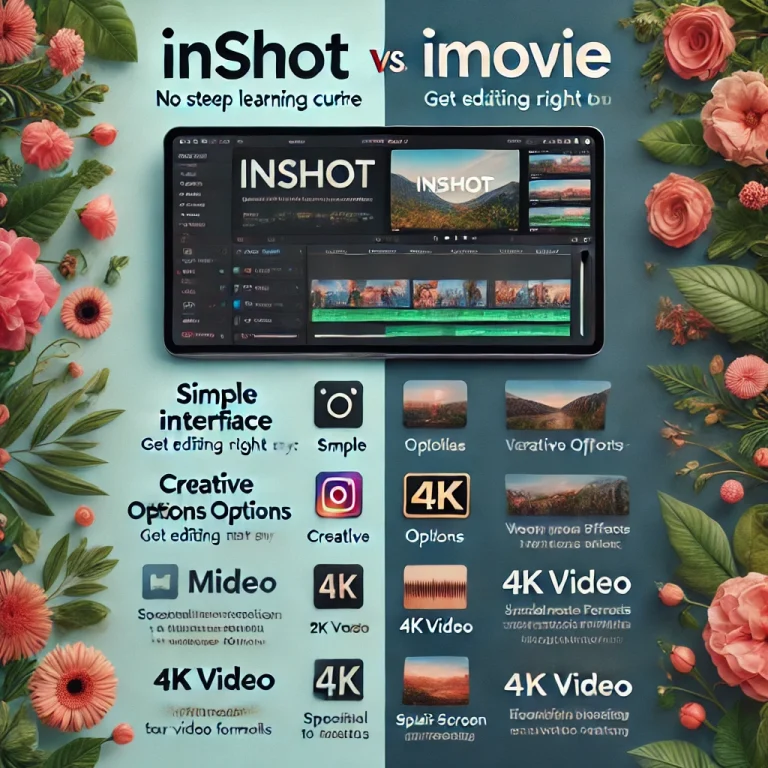Introduction
InShot VS iMovie
Are you trying to decide between InShot and iMovie for your video editing needs? As someone who’s explored both apps, I understand the challenges in picking the right one. In this blog post, I’ll explain all the differences between InShot and iMovie in a simple, easy-to-follow way. By the end, you’ll be able to make a clear decision of which app best fits you, whether you’re a beginner or looking for more advanced editing features. Let’s dive in!

Understanding InShot
For people who want quick and easy editing, inshot is the best option for them. It offers users the ability to edit photos and videos directly on their mobile phones. As i mentioned in the previous blogs that inshot is best for users of all ages. For those who cannot afford big screens like computers to fulfill their editing needs, InShot will definitely help them out. You have lots of choices for trimming clips, adding music applying filters etc.
Key Highlights of InShot
- Simple Interface: it has No steep learning curve—get editing right away.
- Creative Options: It offers a good variety of filters, effects, and music.
- Versatile Formats: this app Works with different video formats, making it flexible.
- Social Media Ready: you can Easily share your edits directly to platforms like Instagram and TikTok.

What iMovie Brings to the Table
iMovie is Apple’s trusted video editing software, built exclusively for iOS and macOS. Imovie is more sophisticated than InShot. It offers tools that help create professional-looking videos. iMovie fits perfectly into the Apple ecosystem, making it easy to use with other Apple apps and devices. It’s ideal for anyone already using Apple products. From high-quality trailers to 4K video support, iMovie gives you the features you need to elevate your video projects.
Key Highlights of iMovie
- High-Quality Themes: it helps to Create cinematic videos with built-in themes and trailers.
- Advanced Editing: Most trending Features like green screen effects and split-screen make it more powerful.
- 4K Video: iMovie Supports 4K editing, and is ideal for those looking for top-tier video quality.
- Apple Ecosystem: it offers Seamless integration with other Apple devices and software for a smooth editing experience.
Comparison: InShot vs iMovie
Ease of Use
InShot is more user-friendly, especially for beginners or those who need quick edits on the go. iMovie, while slightly more complex, offers a richer set of tools for users who want to explore more detailed editing.
Features and Tools
iMovie outshines InShot with its advanced features like green screen effects and 4K video support. However, InShot’s simplicity and mobile-first design make it perfect for quick edits and social media content.
Compatibility
InShot is available on both iOS and Android, making it more accessible. iMovie, however, is limited to Apple users but offers deeper integration with other Apple products.
Price
InShot has a free version with ads and watermarks, with affordable premium options. iMovie is free on Apple devices, providing a high-quality editing experience without any additional cost.

InShot: The Good and the Not-So-Good
What I Like
Easy to Use: InShot is super simple to navigate, even if you’re new to video editing.
Lots of Editing Options: You can trim, cut, add music, text, and filters—everything you need for quick edits.
Affordable: There’s a free version, and the premium upgrades won’t break the bank.
Works on All Devices: Whether you’re on iOS or Android, InShot has you covered.
Where It Falls Short
Limited Export Choices: You might find the export options a bit lacking if you’re used to more advanced tools.
Basic Features: It’s great for simple edits, but don’t expect professional-grade features.
Watermark: The free version leaves a watermark on your videos, which is a bit of a bummer.
No Collaboration: If you’re working on a team project, InShot’s limited collaboration features might not cut it.
iMovie: What Works and What Doesn’t
What I Like
Beautiful Design: iMovie looks and feels polished, especially if you’re already in the Apple ecosystem.
Powerful Tools: It’s got advanced tools like green screen effects and audio editing, perfect for serious editors.
Smooth Performance: Even with large files, iMovie runs like a charm without crashing.
Free for Apple Users: It’s free on Apple devices, so no extra cost if you’re already on a Mac or iPhone.
Where It Falls Short
Apple Only: If you’re not an Apple user, you’re out of luck—iMovie isn’t available on Android or Windows.
Steeper Learning Curve: It’s not as beginner-friendly as some other apps, so it might take time to get the hang of it.
Limited Customization: While it’s powerful, some users might find iMovie a bit restrictive in terms of customization options.
Who Is It For?
InShot
Best suited for beginners, social media enthusiasts, and those who need quick, on-the-go edits. Its ease of use makes it perfect for users who want to create content without diving deep into advanced editing features.
iMovie
Ideal for Apple users who seek more advanced editing tools and are willing to invest a bit more time in learning the software. It’s a great choice for those looking to create professional-quality videos with seamless integration across Apple devices.
CONCLUSION
In conclusion, both InShot and iMovie offer valuable video editing features, but they cater to different needs. InShot is perfect for quick, mobile edits and social media content creation, while iMovie provides more advanced tools for those within the Apple ecosystem seeking higher quality production. Your choice should depend on your specific editing needs and the devices you use.
If this comparison helped you, why not try out both apps to see which one suits you best? Don’t forget to share your experience or ask any questions in the comments below!
FAQs
The Classic Burrito is a staple on the Chipotle menu. It includes a large flour tortilla filled with your choice of protein, rice, beans, and toppings. The flavors blend perfectly to create a satisfying meal. Choose from chicken, steak, barbacoa, carnitas, or sofritas. Each protein is marinated and cooked to perfection.

